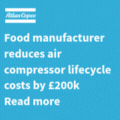
Posted to News on 30th Aug 2013, 11:49
Sustainability and efficiency for pumps
Pumps are energy-hungry devices that make life difficult for engineering operators who are attempting to build sustainability. However, innovations in processes, management and technology are all enabling manufacturers to reduce waste and increase the productivity of pumps, and of plant as a whole. Andy Cruse of ERIKS explains how initiatives such as an organised action plan will significantly maximise pump efficiency.
In most industrial and process operations water is a key utility, along with resources such as electricity and gas. It is estimated that the manufacturing sector uses some 14 per cent of all water consumed in the UK, and any rise in the cost of water supplies will have a significant impact on operating costs. The same is also true of the energy costs required to keep pumps running.
Although manufacturers will be well aware of these points, they may not in the past have considered the cost of pumps to be a critical business issue, perhaps due to a general resignation that energy and raw material costs have for some time been rising at far faster rates and show no sign of abating. True enough, both water and energy costs are inevitably going to rise in the future as factors such as population growth, climate change and growing industrialisation put growing demand on what remains a finite resource.
In the shorter term, the general economic situation, with low levels of growth in many regions, means that pressure remains on manufacturers to maintain operating margins through the most effective control possible of all production resources. In terms of energy consumption this effectively requires that production and maintenance engineers implement a tightly controlled strategy. This strategy is likely to include the reduction of cost by preventing leaks and eliminating waste; improvements in plant efficiency to minimise the consumption energy required to drive pumps, and a positive action plan to programme to recycle waste, to reduce overall consumption, cut disposal costs and comply with increasingly tough legislation.
Sustainability is at the heart of ERIKS Planet+ programme, a new initiative that focuses on innovation and sustainability to provide approaches that reduce energy consumption, waste and pollution while protecting people, business and the environment. ERIKS Planet+ has four key targets: Positive Energy Reduction, with more efficient products; Positive Waste Reduction, through increased recycling and higher product quality; Positive Pollution Reduction, by minimising contamination; and Positive Risk Reduction, by providing a safer working environment.
Innovating for sustainability
Innovating for sustainability can bring benefits to industry as well as the planet, because sustainability is now firmly established as a powerful differentiator in the marketplace. The need to be more energy efficient and increase profits goes hand in hand with the growing change in the attitudes towards more ethical business operations. Customers want, and need, to be sure that they are buying products and equipment that are ISO approved, health and safety approved and sustainable, and proving your credentials in terms of sustainability can minimise costs and boost business.
Targeting waste reduction to balance input with output and designing for minimal impact at every stage of a manufacturing or process production line is a win-win for customers and for industry; by developing more efficient products and processes that consume less energy and create less waste, engineering companies can save money, increase profitability, and reduce carbon footprint for their customers and themselves.
Eliminating inefficiency from pumps and production systems as a whole should be a straightforward process; so too should the implementation of simple management and training techniques to ensure that production staff actively seek to prevent energy waste - indeed, many companies have pioneered effective awareness campaigns that are making an important contribution to profitability.
By developing a clear understanding of how pumps are performing, such as measuring the overall energy consumed and pinpointing areas of high energy use or problem spots, much can be done; for example, the retrofitting of energy-saving features. This can be part of an all-encompassing action plan for pumps that identifies which steps can be taken to achieve maximum effect.
An ongoing assessment of pump condition will boost operating efficiency, and this is where condition monitoring techniques play a valuable role in ensuring the benefits of reduced pump wear, reduced energy consumption and increased productivity. Monitoring pumps in this way can identify any leaks or potential improvements in flow control rather than the use of throttling or by-pass valves. It can also identify whether any process interruptions are occurring during operation; if so, pumping can in future be minimised by the use of simple power on/off control devices.
Repair and replace schedule
As well as providing continuous monitoring, a pump action plan enables the implementation of a fully structured maintenance programme to establish a repair and replace schedule. The replacement of leaking seals, the application of efficiency/wear-resistant coatings and the investigation and rectifying of faults such as cavitation can extend pump life considerably and avoid costly and unnecessary pump replacement. Pump maintenance information can then be recorded to help identify future problems and justify the need for the replacement of faulty pumps when they do not achieve the duty level specified by the manufacturer.
An action plan will also help operators to develop a better understanding of pump operation, provide them with a data log of estimated savings, costs and payback potential, and also inform them of appropriate energy efficiency initiatives.
Today's specialists in plant and machinery maintenance use calculation and action plan methodology as part of a condition monitoring regime for a large number of companies throughout industry. This approach to pump management is proven to offer significant savings in terms of running costs, extended pump life and, through a planned maintenance programme, the virtual elimination of unexpected breakdowns that can prove costly to productivity.
An action plan begins with an estimation of the energy cost of running your pumps, with the initial focus on the equipment that uses the highest level of energy. As mentioned earlier, it may be possible to retrofit energy-saving features, the costs of which can soon be recovered by efficiency gains. Stage two of an action plan should introduce efficient condition monitoring practices, routine checking and data logging of pump performance. This should be followed by repairs and refurbishments, such as the application of wear-resistant coatings, and the replacement of leaking seals.
One powerful method of increasing efficiency that can be introduced to pumps is to add a variable speed drive. The British Pump Manufacturers Association has reported that 74 million of savings have been made in the UK since the introduction of variable speed drives and high-efficiency motors. The variable speed drive will not only save energy but also reduce shock loading with features such as "soft start' and programmable ramp times, minimising both maintenance and operating costs. Statistically, using a Fenner QD Inverter to vary the speed of an electric motor can deliver significant energy and cost savings. Variable torque applications such as centrifugal pumps running continuously over a long period offer the biggest savings opportunities, with a 20 per cent reduction in speed, resulting in a 50 per cent energy saving. Motor efficiency is also enhanced by upgrading to an IE3 motor, which offers even greater energy efficiency than the IE2-rated motor now required within the EU.
Maximise efficiency
Wear and tear is unavoidable but in pumps, where abrasive particles and poor water quality lead to erosion and corrosion, attention to the most vulnerable areas can maximise efficiency. For example, wear to the neck rings leads to an increase in clearance. This in turn causes leakage and recirculation from the high-pressure area of the pump casing back to the suction side of the impeller. The result of this is reduced head and flow, which is a constant cause of poor energy efficiency if not managed correctly.
It is also worth noting that high temperatures in rotating components such as pumps can indicate potential mechanical problems, perhaps caused by poor lubrication or shaft misalignment; regular temperature monitoring can therefore help improve uptime and extend the operating life of equipment. By isolating hot spots in the structure of a pump system, it is possible to identify areas where energy can be saved.
Temperature monitoring is carried out using portable thermal imaging cameras. These measure infrared radiation and convert the information gathered to a readout in visible light, with varying intensities of temperature being represented by different colours. The latest devices are lightweight, compact and robust and can provide high levels of accuracy and image definition, giving sharp images even when the camera or target is moving.
Vibration is often the cause of such heat and energy losses. Most vibration occurs within rotating systems, often where it is hard to detect and where it only becomes obvious when components - typically bearings - fail. Measuring vibration can be achieved using small fixed accelerometers, permanently connected to plant-wide monitoring systems, or plugged into portable meters. Alternatively, hand-held probes can be used where equipment is accessible. In each case, data is normally collected over time, so that deterioration in operating conditions can be identified and resolved before problems occur.
Step-by-step approach
Wasted energy can add many thousands of pounds to factory costs each year and that money that comes straight off the bottom line. Most factory managers and maintenance personnel will know these facts only too well. Of course, recognising the need to reduce energy consumption and then having the time and resources to make positive change, when you are faced with a hundred and one other often more pressing day-to-day issues, can be a considerable challenge. There is rarely a quick fix that will solve all problems. Instead, the solution is likely to lay in a gradual, step-by-step approach to many different areas where energy is being wasted: for example, through unlagged pipes, poorly fitted refrigerator doors, unregulated motors, pumps or fans, and leaking compressed air lines. But there are plenty of opportunities out there to strengthen pump systems and plant as a whole by enhancing the efficiency. And increasingly, thanks to ongoing innovation, you can reduce waste and increase productivity while simultaneously integrating environmentally sustainable products and systems into your operations.
ERIKS has provided support for pumps on a grand scale, with contracts for organisations such as South West Water, the provider of drinking and waste water services throughout Devon and Cornwall. This ongoing relationship has been the result of excellent scores for commercial, service, innovation and organisational capacities. With the capability to provide efficient maintenance at this level to meet the stringent KPI targets of service delivery, a service provider such as ERIKS can offer a range of options for manufacturing and process operators that build sustainability into pumps and beyond.
For further information about pump efficiency, please email [email protected], or visit the website at www.eriks.co.uk.




